Assessing the Influence of Seasonal and Spatial Variations on the Estimation of Secondary Organic Carbon in Urban Particulate Matter by Applying the EC-Tracer Method
Abstract
:1. Introduction
2. Experimental Section
2.1. Sampling
2.2. Analysis
2.3. PMF-Analysis
2.4. EC-Tracer-Method
2.4.1. Application with Regard to Temporal and Spatial Variation

2.4.2. Calculation of [OC/EC]p and SOC
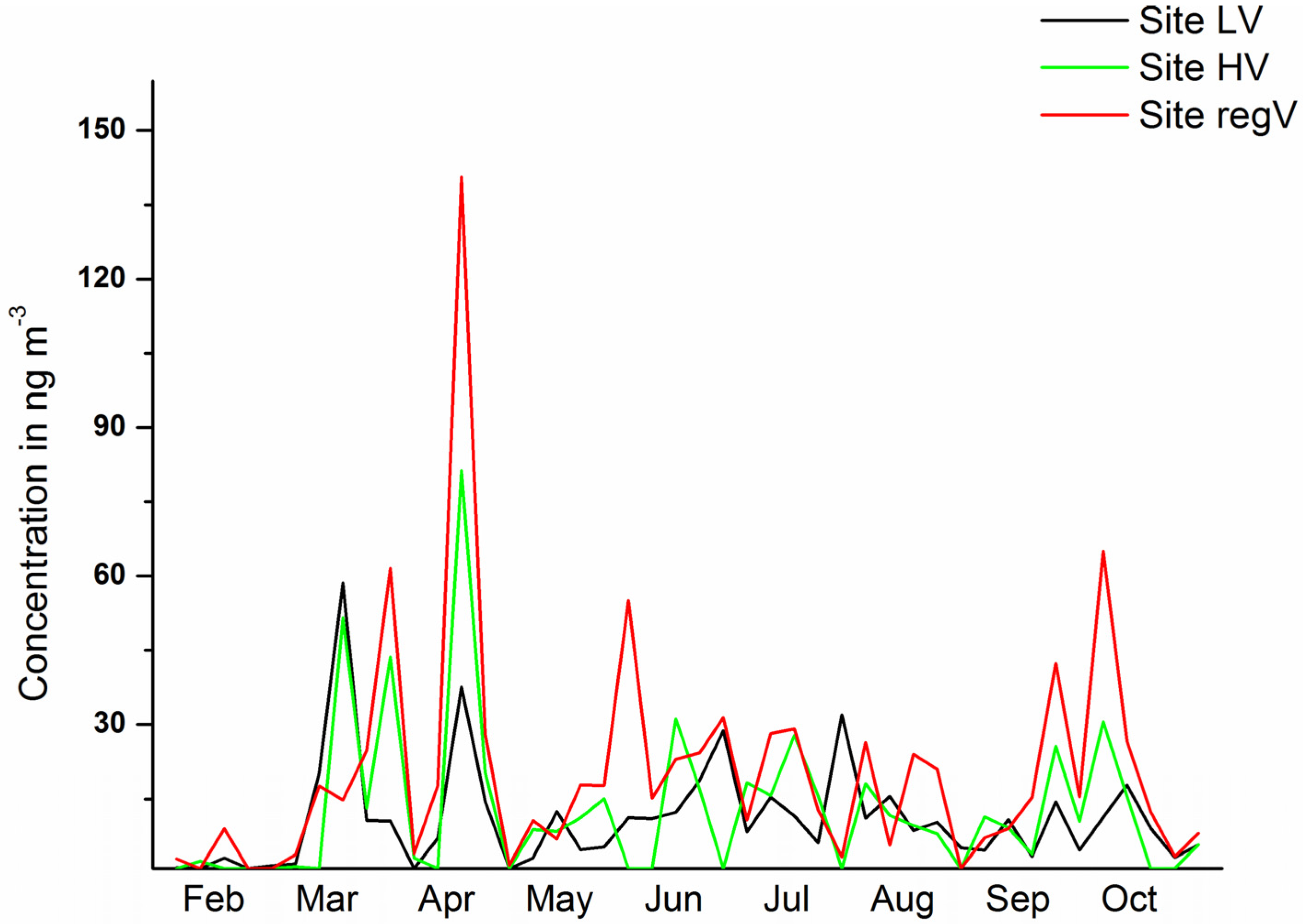
3. Results and Discussion
3.1. OC and EC
3.1.1. Concentrations
3.1.2. Influence of Biomass Burning, SOA and Traffic on OC/EC-Ratios
| PM10 | PM1 | |||||
|---|---|---|---|---|---|---|
| OC | EC | OC/EC | OC | EC | OC/EC | |
| HV | 4.1 ± 2.4 | 0.6 ± 0.4 | 5.7 ± 2.1 | 2.7 ± 1.5 | 0.6 ± 0.3 | 4.3 ± 1.7 |
| LV | 4.9 ± 2.5 | 3.0 ± 1.5 | 1.8 ±1.0 | 2.6 ± 1.3 | 2.3 ± 1.1 | 1.1 ± 0.7 |
| regV | 4.3 ± 2.3 | 0.6 ± 0.3 | 6.5 ± 2.5 | |||
| HV | LV | regV | |||||||||||||
|---|---|---|---|---|---|---|---|---|---|---|---|---|---|---|---|
| PM10 | EC | OC/EC | Levo. | SOA | NOx | EC | OC/EC | Levo. | SOA | NOx | EC | OC/EC | Levo. | SOA | NOx |
| OC | 0.83 | 0.43 | 0.49 | 0.18 | 0.17 | 0.62 | 0.38 | 0.26 | 0.34 | 0.73 | 0.51 | 0.41 | 0.17 | 0.06 | |
| EC | −0.18 | 0.68 | 0.03 | 0.35 | −0.41 | −0.19 | 0.23 | −0.4 | 0.69 | 0.02 | 0.38 | ||||
| OC/EC | −0.21 | 0.38 | −0.18 | 0.58 | 0.26 | −0.21 | 0.30 | −0.39 | |||||||
| PM1 | |||||||||||||||
| OC | 0.80 | 0,36 | 0.54 | 0.30 | 0.17 | 0.56 | 0.38 | 0.48 | 0.31 | ||||||
| EC | −0.35 | 0.7 | 0,08 | 0.34 | −0.57 | 0.05 | 0.22 | ||||||||
| OC/EC | −0.25 | 0.48 | −0.35 | 0.57 | 0.14 | ||||||||||
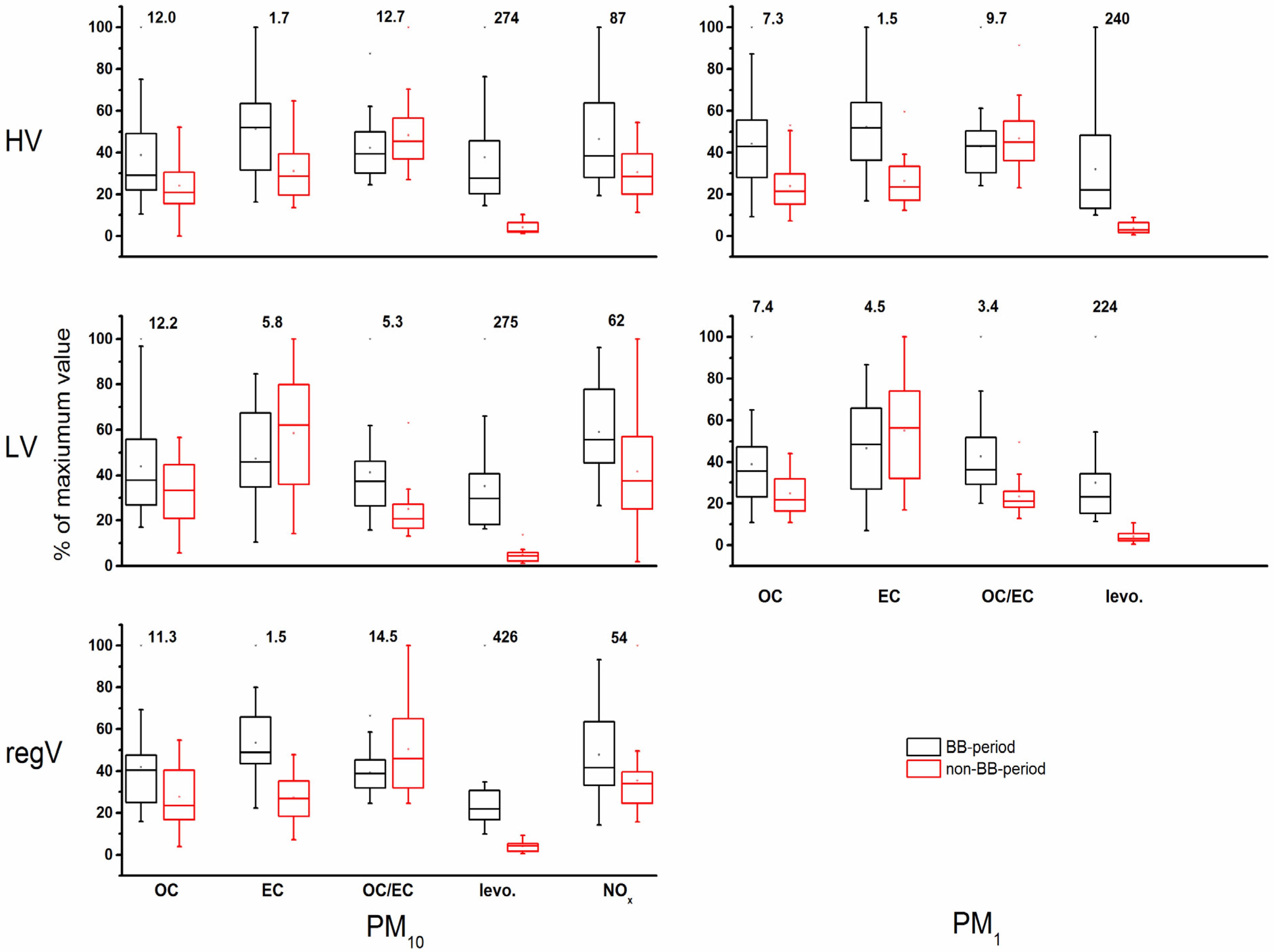
3.2. Results by EC-Tracer-Method
| BB-Period | R2 | [OC/EC]p | Intercept | Conc. SOC | % conc. | PMF SOC | PMF POCbio | |
|---|---|---|---|---|---|---|---|---|
| PM10 | HV | 0.80 | 2.6 ± 0.5 | 0.8 ± 0.2 | 1.33 (0.69) | 21 (21) | 0.83 (0.41) | 0.8 (0.6) |
| PM1 | HV | 0.49 | 2.1 ± 0.8 | 1.0 ± 0.5 | 0.72 (0.29) | 11 (9) | 0.86 (0.83) | 0.2 (0.1) |
| PM10 | LV | 0.30 | 1.0 ± 0.4 | 1.5 ± 1.1 | 1.12 (0.46) | 16 (14) | 0.60 (0.20) | 0.6 (0.5) |
| PM1 | LV | 0.93 | 1.1 ± 0.1 | 0.03 ± 0.1 | 0.49 (0.22) | 11 (9) | 0.56 (0.34) | 0.2 (0.1) |
| regV | 0.53 | 4.1 ± 1.3 | 0.3 ± 0.8 | 0.82 (0.53) | 12 (12) | 0.76 (0.42) | 0.8 (0.5) | |
| NonBB-Period | ||||||||
| PM10 | HV | 0.92 | 5.6 ± 0.6 | −0.3 ± 0.3 | 0.45 (0.49) | 15 (16) | 1.00 (1.30) | 0.9 (0.6) |
| PM1 | HV | 0.94 | 2.0 ± 0.2 | 0.3 ± 0.1 | 0.65 (0.56) | 33 (43) | 1.01 (0.93) | 0.2 (0.2) |
| PM10 | LV | 0.58 | 0.7 ± 0.2 | 0.8 ± 0.5 | 0.98 (1.06) | 18 (23) | 0.8 0 (0.50) | 0.8 (0.7) |
| PM1 | LV | 0.58 | 0.3 ± 0.1 | 0.6 ± 0.1 | 0.44 (0.45) | 17 (22) | 0.71 (0.39) | 0.3 (0.2) |
| regV | 0.63 | 3.6 ± 1.0 | 0.4 ± 0.2 | 1.21 (0.88) | 26 (33) | 1.59 (0.91) | 0.9 (0.7) | |
3.2.2. SOC-Concentrations
3.3. Comparison of SOC-Concentrations and Noncombustion OC between EC-Tracer and PMF
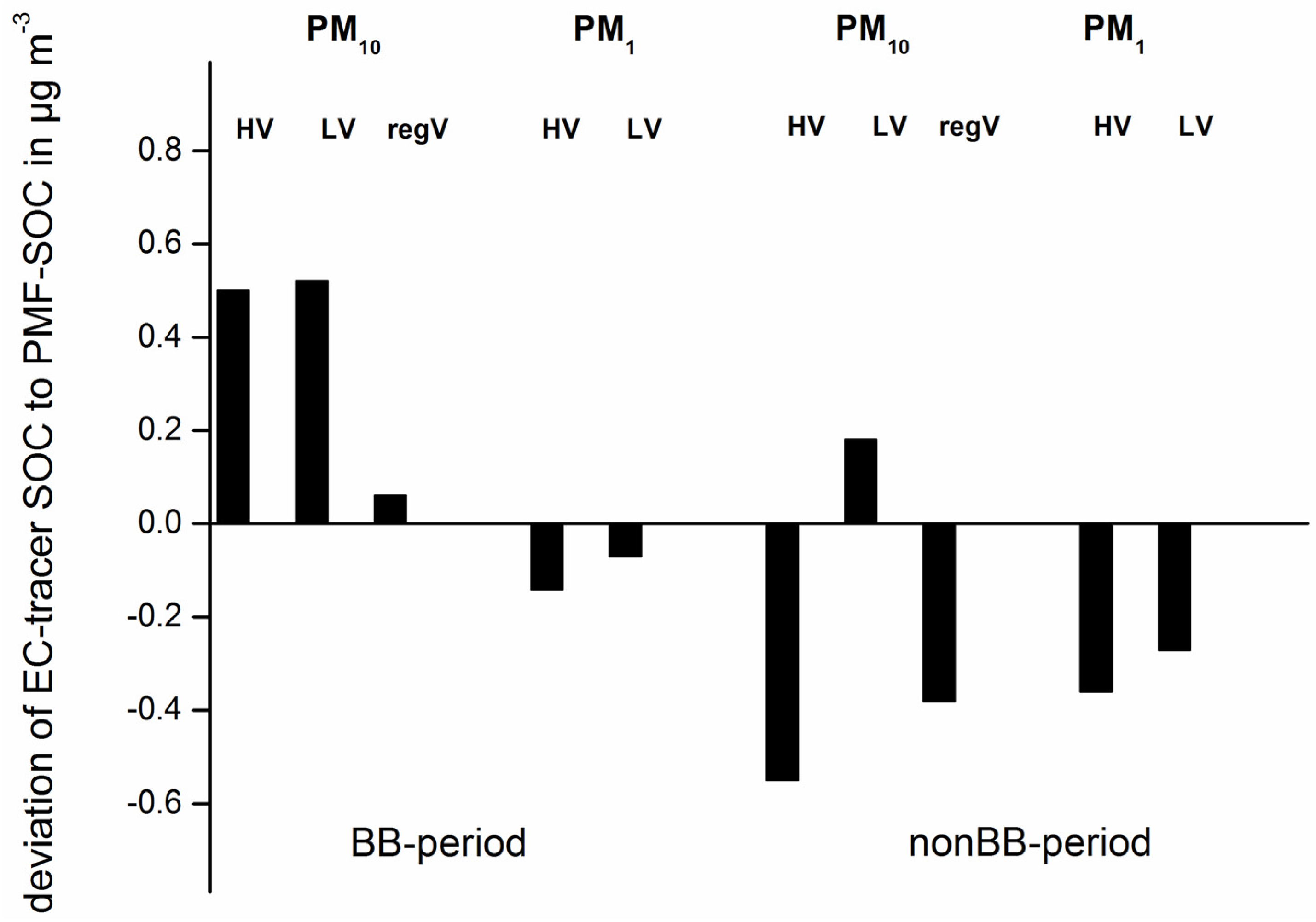
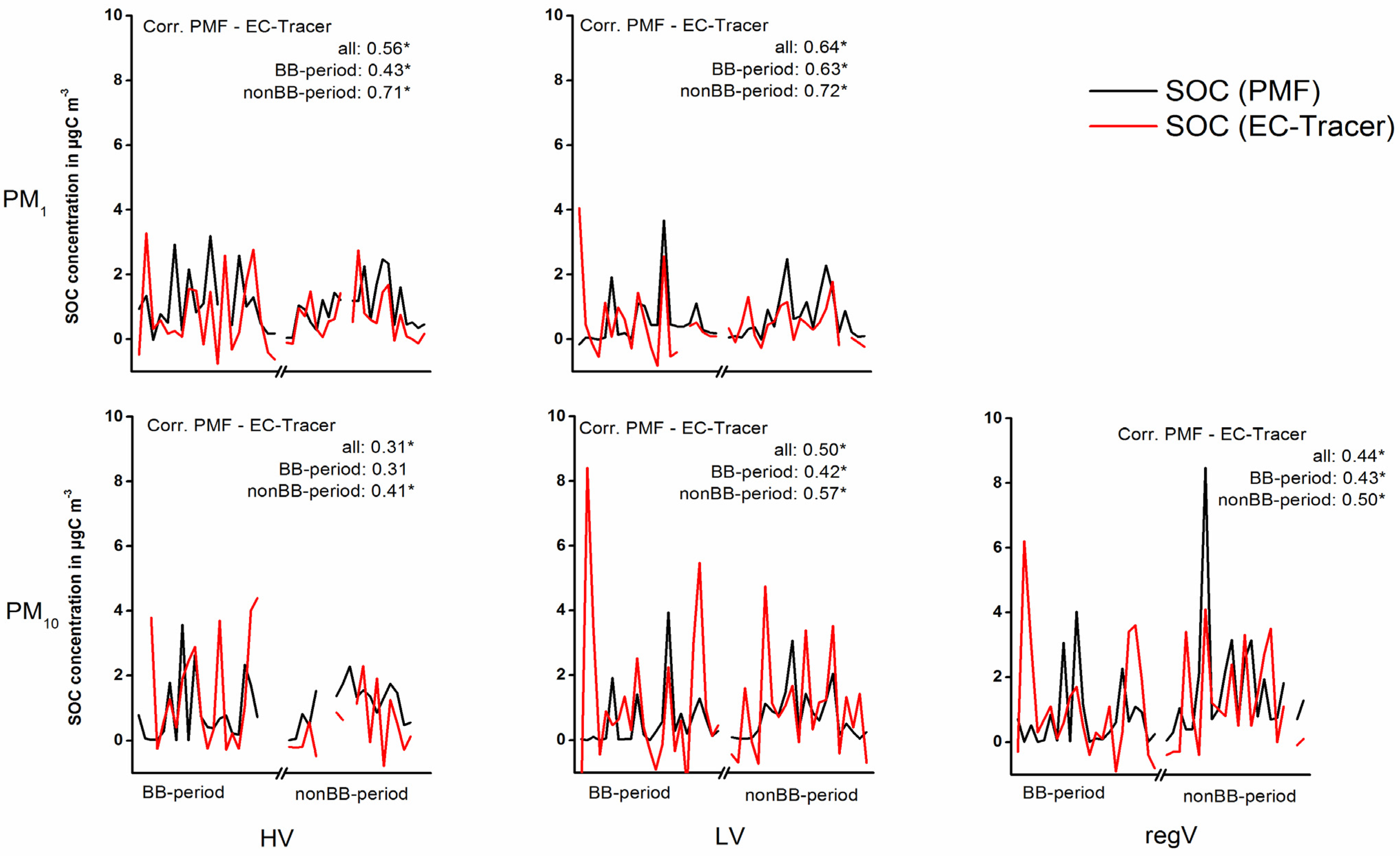
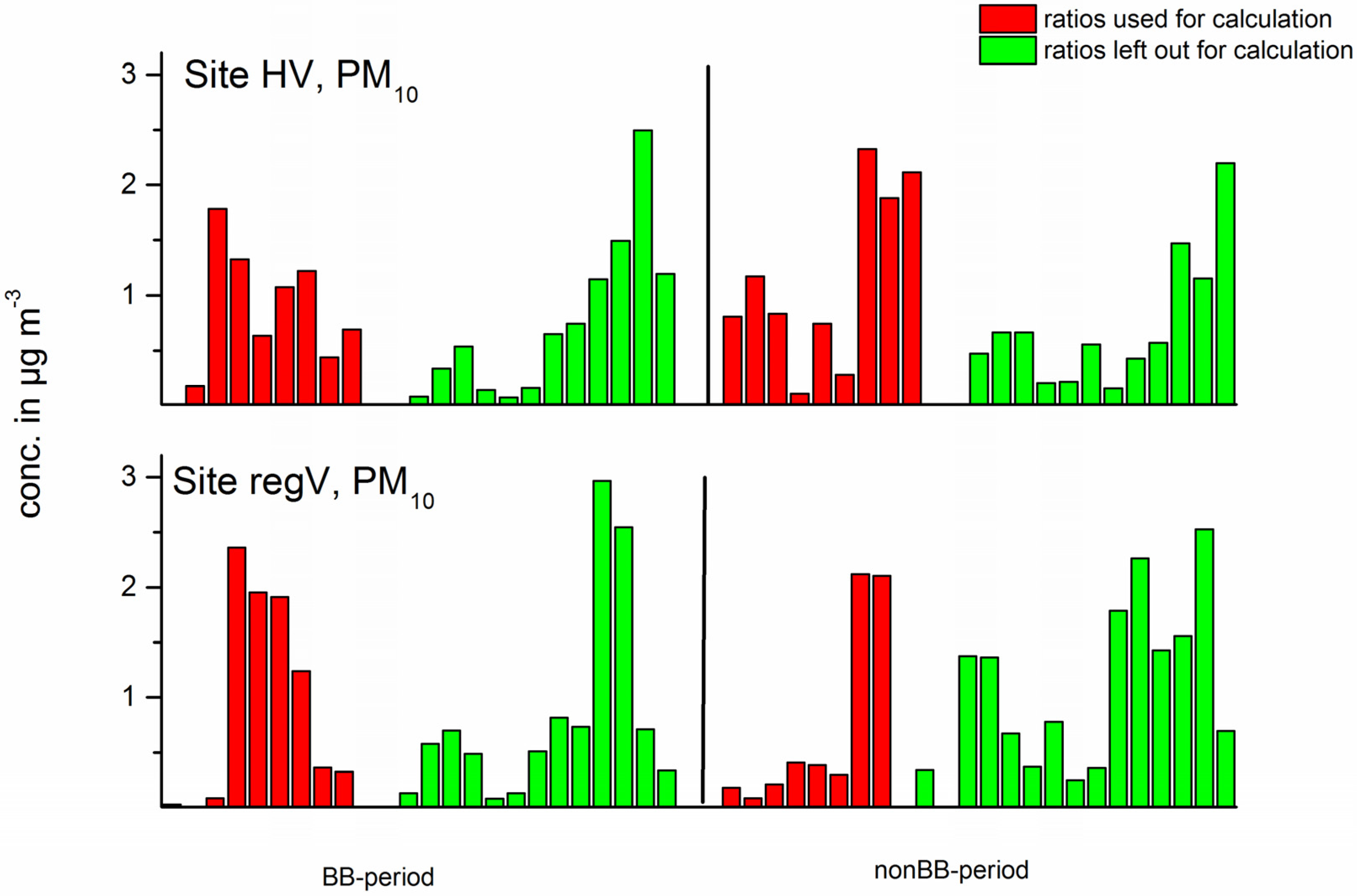
4. Summary and Conclusions
Acknowledgments
Author Contributions
Conflicts of Interest
References
- Ramanathan, V.; Crutzen, P.J.; Kiehl, J.T.; Rosenfeld, D. Aerosols, climate, and the hydrological cycle. Science 2001, 294, 2119–2124. [Google Scholar] [CrossRef]
- Facchini, M.C.; Mircea, M.; Fuzzi, S.; Charlson, R.J. Cloud albedo enhancement by surface-active organic solutes in growing droplets. Nature 1999, 401, 257–259. [Google Scholar] [CrossRef]
- Pope, C.A.; Burnett, R.T.; Thurston, G.D.; Thun, M.J.; Calle, E.E.; Krewski, D.; Godleski, J.J. Cardiovascular mortality and long-term exposure to particulate air pollution—Epidemiological evidence of general pathophysiological pathways of disease. Circulation 2004, 109, 71–77. [Google Scholar]
- Ruckerl, R.; Schneider, A.; Breitner, S.; Cyrys, J.; Peters, A. Health effects of particulate air pollution: A review of epidemiological evidence. Inhal. Toxicol. 2011, 23, 555–592. [Google Scholar] [CrossRef]
- Lonati, G.; Ozgen, S.; Giugliano, M. Primary and secondary carbonaceous species in PM2.5 samples in Milan (Italy). Atmos. Environ. 2007, 41, 4599–4610. [Google Scholar] [CrossRef]
- Kim, B.M.; Teffera, S.; Zeldin, M.D. Characterization of PM2.5 and PM10 in the south coast air basin of southern California: Part 1—Spatial variations. J. Air Waste Manag. 2000, 50, 2034–2044. [Google Scholar] [CrossRef]
- Lee, H.S.; Kang, B.W. Chemical characteristics of principal PM2.5 species in Chongju, South Korea. Atmos. Environ. 2001, 35, 739–746. [Google Scholar] [CrossRef]
- Yang, F.M.; He, K.B.; Ma, Y.L.; Zhang, Q.; Cadle, S.H.; Chan, T.; Mulawa, P.A. Characterization of carbonaceous species of ambient PM2.5 in Beijing, China. J. Air Waste Manag. 2005, 55, 984–992. [Google Scholar] [CrossRef]
- Ye, B.M.; Ji, X.L.; Yang, H.Z.; Yao, X.H.; Chan, C.K.; Cadle, S.H.; Chan, T.; Mulawa, P.A. Concentration and chemical composition of PM2.5 in Shanghai for a 1-year period. Atmos. Environ. 2003, 37, 499–510. [Google Scholar] [CrossRef]
- Seinfeld, J.H.; Pandis, S.N. Atmospheric Chemistry and Physics, 2nd ed.; John Wiley & Sons: New York, NY, USA, 2006. [Google Scholar]
- Tsigaridis, K.; Kanakidou, M. Global modelling of secondary organic aerosol in the troposphere: A sensitivity analysis. Atmos. Chem. Phys. 2003, 3, 1849–1869. [Google Scholar] [CrossRef]
- Paatero, P.; Tapper, U. Positive matrix factorization: A non-negative factor model with optimal utilization of error estimates of data values. Environmetrics 1994, 5, 111–126. [Google Scholar] [CrossRef]
- Hu, D.; Bian, Q.J.; Lau, A.K.H.; Yu, J.Z. Source apportioning of primary and secondary organic carbon in summer PM2.5 in Hong Kong using positive matrix factorization of secondary and primary organic tracer data. J. Geophys. Res. Atmos. 2010. [Google Scholar] [CrossRef]
- Wagener, S.; Langner, M.; Hansen, U.; Moriske, H.-J.; Endlicher, W. Source apportionment of organic compounds in Berlin using positive matrix factorization—Assessing the impact of biogenic aerosol and biomass burning on urban particulate matter. Sci. Total Environ. 2012, 435–436, 392–401. [Google Scholar]
- Zhang, Y.; Sheesley, R.J.; Schauer, J.J.; Lewandowski, M.; Jaoui, M.; Offenberg, J.H.; Kleindienst, T.E.; Edney, E.O. Source apportionment of primary and secondary organic aerosols using positive matrix factorization (PMF) of molecular markers. Atmos. Environ. 2009, 43, 5567–5574. [Google Scholar] [CrossRef]
- Cabada, J.C.; Pandis, S.N.; Subramanian, R.; Robinson, A.L.; Polidori, A.; Turpin, B. Estimating the secondary organic aerosol contribution to PM2.5 using the EC tracer method. Aerosol. Sci. Technol. 2004, 38, 140–155. [Google Scholar]
- Turpin, B.J.; Huntzicker, J.J. Identification of secondary organic aerosol episodes and quantitation of primary and secondary organic aerosol concentrations during scaqs. Atmos. Environ. 1995, 29, 3527–3544. [Google Scholar] [CrossRef]
- Yuan, Z.B.; Yu, J.Z.; Lau, A.K.H.; Louie, P.K.K.; Fung, J.C.H. Application of positive matrix factorization in estimating aerosol secondary organic carbon in Hong Kong and its relationship with secondary sulfate. Atmos. Chem. Phys. 2006, 6, 25–34. [Google Scholar] [CrossRef]
- Strader, R.; Lurmann, F.; Pandis, S.N. Evaluation of secondary organic aerosol formation in winter. Atmos. Environ. 1999, 33, 4849–4863. [Google Scholar] [CrossRef]
- Seguel, R.; Morales, R.G.E.; Leiva, M.A. Estimations of primary and secondary organic carbon formation in PM2.5 aerosols of Santiago City, Chile. Atmos. Environ. 2009, 43, 2125–2131. [Google Scholar] [CrossRef]
- Pio, C.; Cerqueira, M.; Harrison, R.M.; Nunes, T.; Mirante, F.; Alves, C.; Oliveira, C.; de la Campa, A.S.; Artinano, B.; Matos, M. OC/EC ratio observations in Europe: Re-thinking the approach for apportionment between primary and secondary organic carbon. Atmos. Environ. 2011, 45, 6121–6132. [Google Scholar] [CrossRef]
- Wagener, S.; Langner, M.; Hansen, U.; Moriske, H.-J.; Endlicher, W.R. Spatial and seasonal variations of biogenic tracer compounds in ambient PM10 and PM1 samples in Berlin, Germany. Atmos. Environ. 2012, 47, 33–42. [Google Scholar] [CrossRef]
- Niosh, Elemental Carbon (Diesel Particulate): Method 5040. In NIOSH Manual of Analytical Methods, 4th ed. (1st Supplement), Eller, P.M.; Cassinelli, M.E. (Eds.) National Institute for Occupational Safety and Health: Cincinatti, OH, USA, 1996. Available online: http://www.cdc.gov/niosh/docs/2003-154/pdfs/5040f3.pdf (accessed on 15 April 2012).
- Cavalli, F.; Viana, M.; Yttri, K.E.; Genberg, J.; Putaud, J.P. Toward a standardised thermal-optical protocol for measuring atmospheric organic and elemental carbon: The EUSAAR protocol. Atmos. Meas. Tech. 2010, 3, 79–89. [Google Scholar] [CrossRef] [Green Version]
- Turpin, B.J.; Huntzicker, J.J. Secondary formation of organic aerosol in the los-angeles basin—A descriptive analysis of organic and elemental carbon concentrations. Atmos. Environ. Part AGen. Top. 1991, 25, 207–215. [Google Scholar] [CrossRef]
- Jordan, T.B.; Seen, A.J.; Jacobsen, G.E. Levoglucosan as an atmospheric tracer for woodsmoke. Atmos. Environ. 2006, 40, 5316–5321. [Google Scholar] [CrossRef]
- Yan, B.; Zheng, M.; Hu, Y.T.; Ding, X.; Sullivan, A.P.; Weber, R.J.; Baek, J.; Edgerton, E.S.; Russell, A.G. Roadside, urban, and rural comparison of primary and secondary organic molecular markers in Ambient PM(2.5). Environ. Sci. Technol. 2009, 43, 4287–4293. [Google Scholar] [CrossRef]
- Park, S.S.; Bae, M.S.; Schauer, J.J.; Ryu, S.Y.; Kim, Y.J.; Cho, S.Y.; Kim, S.J. Evaluation of the TMO and TOT methods for OC and EC measurements and their characteristics in PM2.5 at an urban site of Korea during ACE-Asia. Atmos. Environ. 2005, 39, 5101–5112. [Google Scholar] [CrossRef]
- Lim, H.J.; Turpin, B.J. Origins of primary and secondary organic aerosol in Atlanta: Results of time-resolved measurements during the Atlanta supersite experiment. Environ. Sci. Technol. 2002, 36, 4489–4496. [Google Scholar] [CrossRef]
- Turpin, B.J.; Huntzicker, J.J.; Larson, S.M.; Cass, G.R. Los-Angeles summer midday particulate carbon—primary and secondary aerosol. Environ. Sci. Technol. 1991, 25, 1788–1793. [Google Scholar] [CrossRef]
- Castro, L.M.; Pio, C.A.; Harrison, R.M.; Smith, D.J.T. Carbonaceous aerosol in urban and rural European atmospheres: Estimation of secondary organic carbon concentrations. Atmos. Environ. 1999, 33, 2771–2781. [Google Scholar] [CrossRef]
- Castanho, A.D.A.; Artaxo, P. Wintertime and summertime Sao Paulo aerosol source apportionment study. Atmos. Environ. 2001, 35, 4889–4902. [Google Scholar] [CrossRef]
- He, K.B.; Yang, F.M.; Ma, Y.L.; Zhang, Q.; Yao, X.H.; Chan, C.K.; Cadle, S.H.; Chan, T.; Mulawa, P.A. The characteristics of PM2.5 in Beijing, China. Atmos. Environ. 2001, 35, 4959–4970. [Google Scholar] [CrossRef]
- Na, K.S.; Sawant, A.A.; Song, C.; Cocker, D.R. Primary and secondary carbonaceous species in the atmosphere of western riverside county, California. Atmos. Environ. 2004, 38, 1345–1355. [Google Scholar] [CrossRef]
- Gelencser, A.; May, B.; Simpson, D.; Sanchez-Ochoa, A.; Kasper-Giebl, A.; Puxbaum, H.; Caseiro, A.; Pio, C.; Legrand, M. Source apportionment of PM2.5 organic aerosol over Europe: Primary/secondary, natural/anthropogenic, and fossil/biogenic origin. J. Geophys. Res.: Atmos. 2007. [Google Scholar] [CrossRef]
- Fine, P.M.; Cass, G.R.; Simoneit, B.R.T. Chemical characterization of fine particle emissions from the wood stove combustion of prevalent United States tree species. Environ. Eng. Sci. 2004, 21, 705–721. [Google Scholar] [CrossRef]
- Plaza, J.; Gomez-Moreno, F.J.; Nunez, L.; Pujadas, M.; Artinano, B. Estimation of secondary organic aerosol formation from semicontinuous OC-EC measurements in a Madrid suburban area. Atmos. Environ. 2006, 40, 1134–1147. [Google Scholar] [CrossRef]
- Keywood, M.; Guyes, H.; Selleck, P.; Gillett, R. Quantification of secondary organic aerosol in an Australian urban location. Environ. Chem. 2011, 8, 115–126. [Google Scholar] [CrossRef]
- Robert, M.A.; Kleeman, M.J.; Jakober, C.A. Size and composition distributions of particulate matter emissions: Part 2—Heavy-duty diesel vehicles. J. Air Waste Manag. 2007, 57, 1429–1438. [Google Scholar] [CrossRef]
- Robert, M.A.; VanBergen, S.; Kleeman, M.J.; Jakober, C.A. Size and composition distributions of particulate matter emissions: Part 1—Light-duty gasoline vehicles. J. Air Waste Manag. 2007, 57, 1414–1428. [Google Scholar] [CrossRef]
- Tritscher, T.; Juranyi, Z.; Martin, M.; Chirico, R.; Gysel, M.; Heringa, M.F.; DeCarlo, P.F.; Sierau, B.; Prevot, A.S.H.; Weingartner, E.; et al. Changes of hygroscopicity and morphology during ageing of diesel soot. Environ. Res. Lett. 2011, 6. [Google Scholar]
- Senate Department for Urban Development and the Environment, 2010. Available online: http://fbinter.stadt-berlin.de/fb/index.jsp?loginkey=showAreaSelection%20&mapId=k07_01verkmeng2005@senstadt&areaSelection=address (accessed on 20 March 2011).
Appendix
| PM10 | PM1 | ||||
|---|---|---|---|---|---|
| HV | LV | regV | HV | LV | |
| BB-period | SOA < 10 | SOA < 5 | SOA < 10 | SOA < 6 SOA < 7 | |
| Non-BB-period | SOA < 12 | SOA < 7 | SOA < 17 | ||
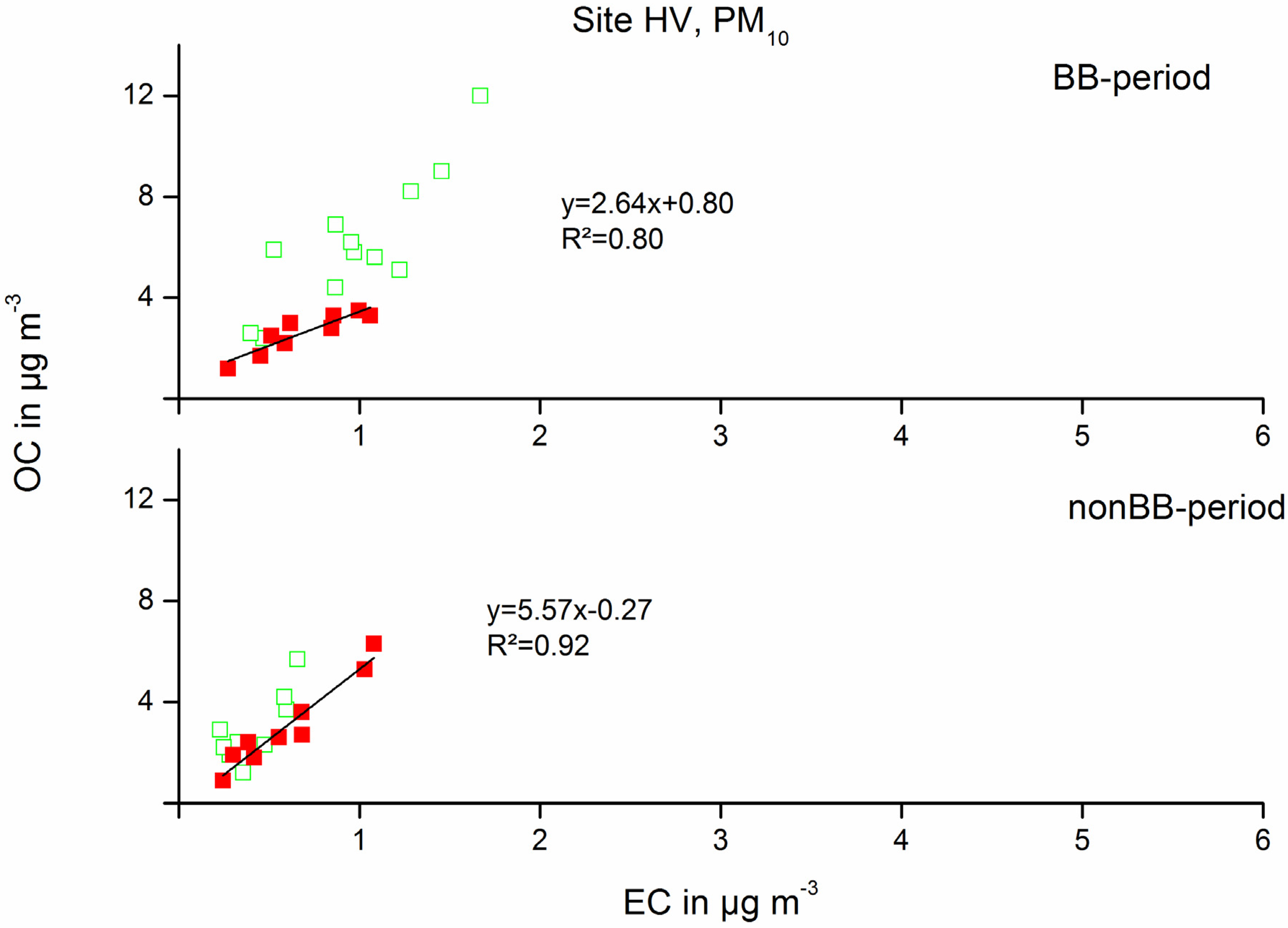
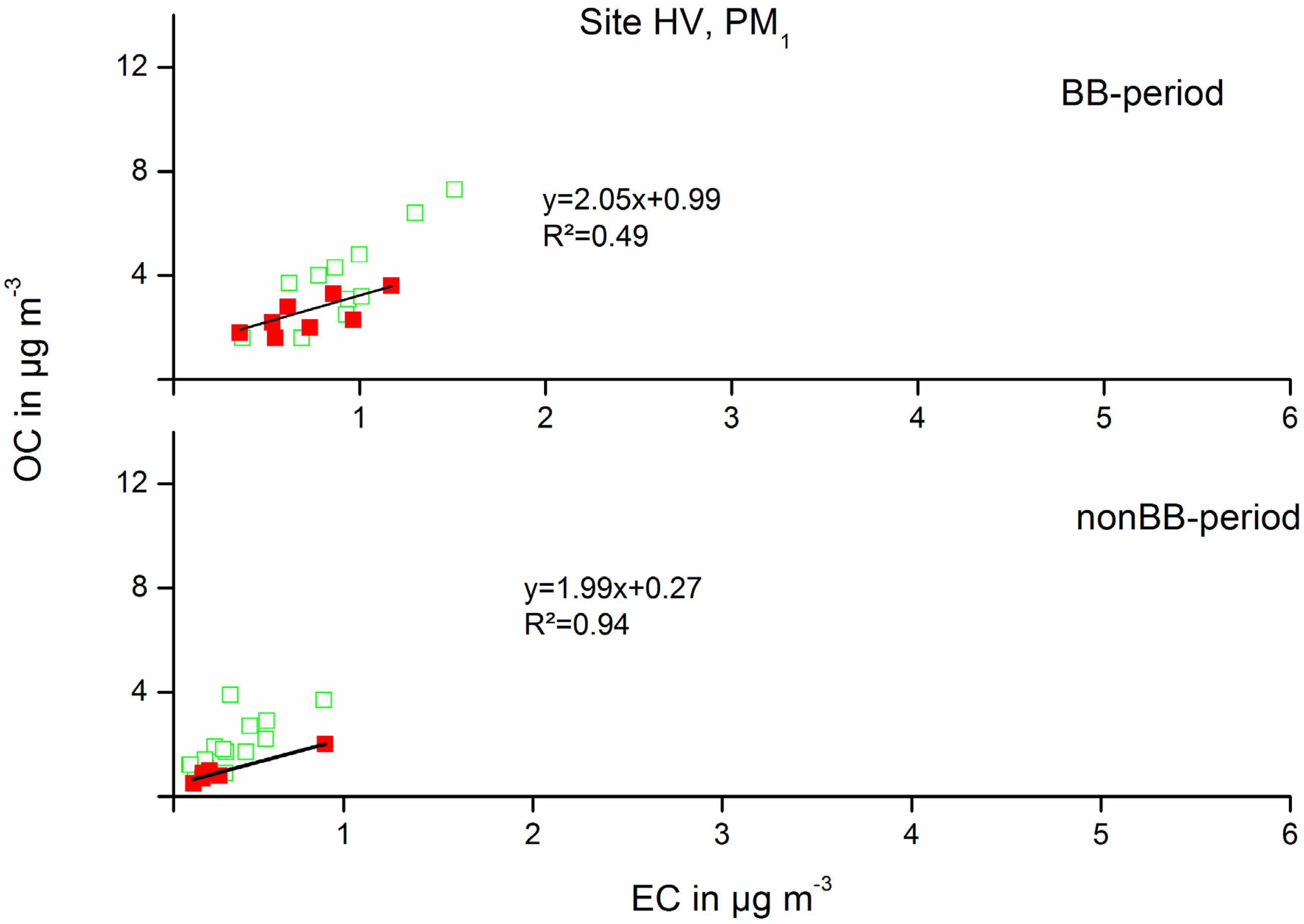

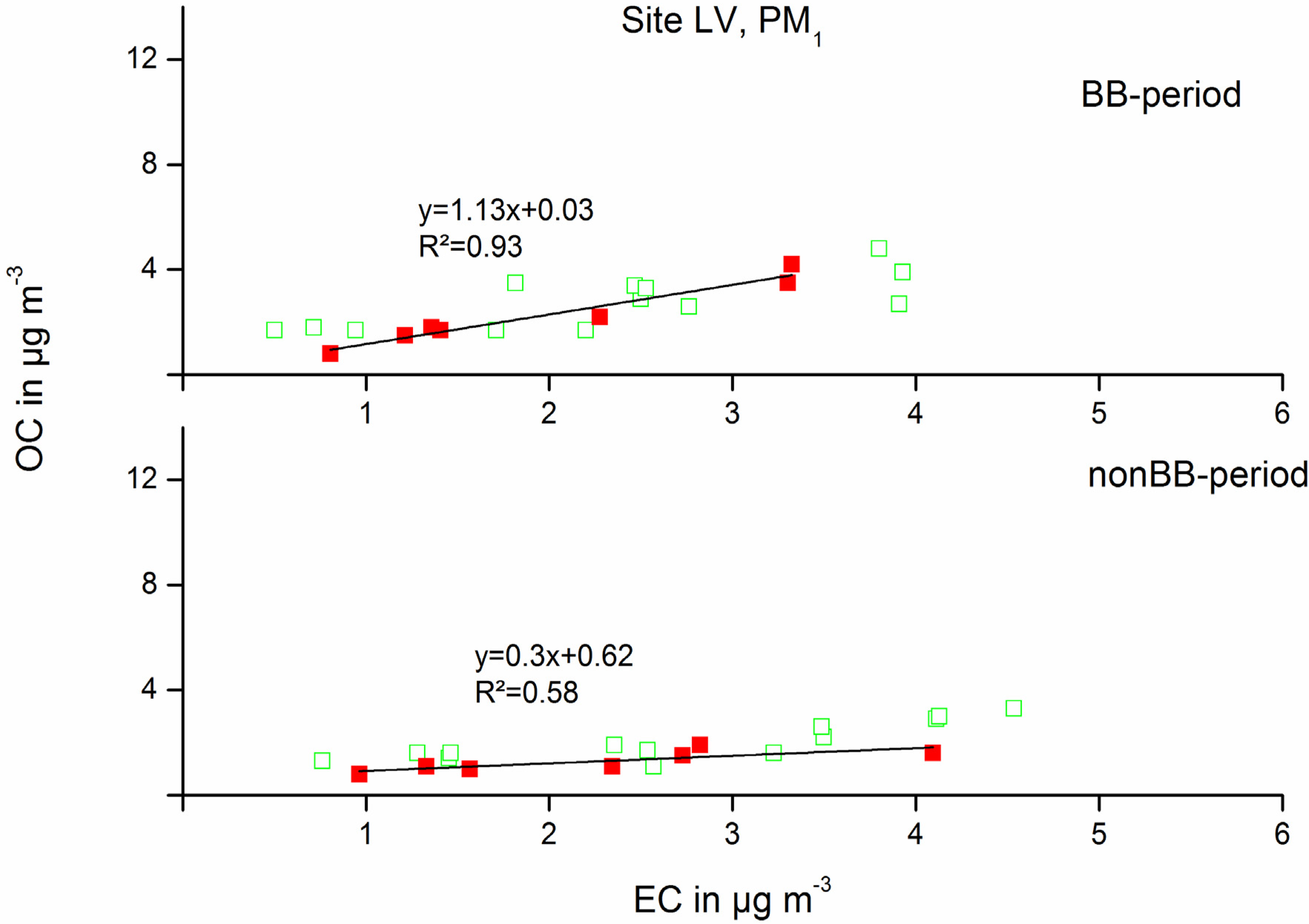
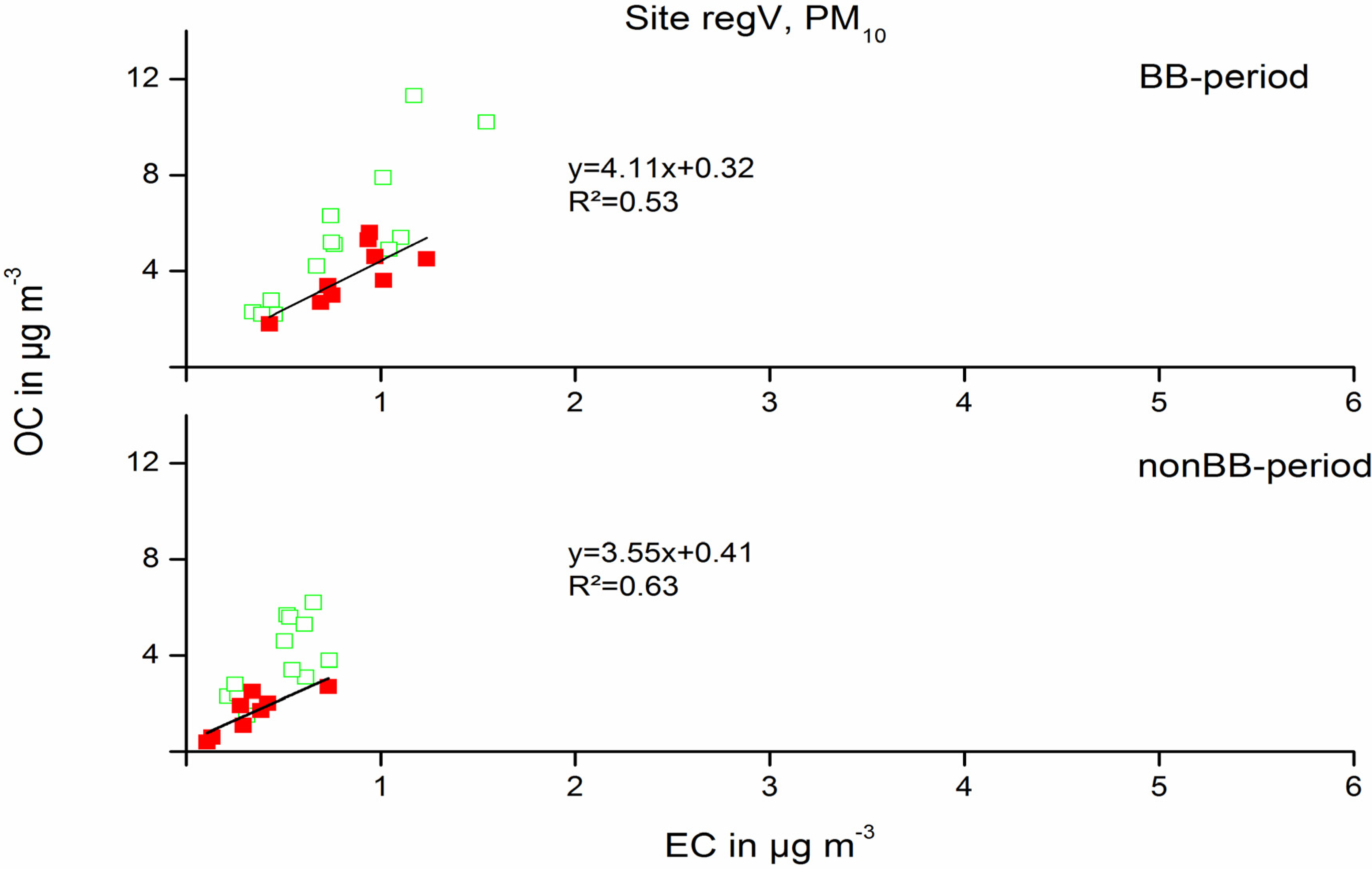
© 2014 by the authors; licensee MDPI, Basel, Switzerland. This article is an open access article distributed under the terms and conditions of the Creative Commons Attribution license (http://creativecommons.org/licenses/by/3.0/).
Share and Cite
Wagener, S.; Langner, M.; Hansen, U.; Moriske, H.-J.; Endlicher, W.R. Assessing the Influence of Seasonal and Spatial Variations on the Estimation of Secondary Organic Carbon in Urban Particulate Matter by Applying the EC-Tracer Method. Atmosphere 2014, 5, 252-272. https://doi.org/10.3390/atmos5020252
Wagener S, Langner M, Hansen U, Moriske H-J, Endlicher WR. Assessing the Influence of Seasonal and Spatial Variations on the Estimation of Secondary Organic Carbon in Urban Particulate Matter by Applying the EC-Tracer Method. Atmosphere. 2014; 5(2):252-272. https://doi.org/10.3390/atmos5020252
Chicago/Turabian StyleWagener, Sandra, Marcel Langner, Ute Hansen, Heinz-Jörn Moriske, and Wilfried R. Endlicher. 2014. "Assessing the Influence of Seasonal and Spatial Variations on the Estimation of Secondary Organic Carbon in Urban Particulate Matter by Applying the EC-Tracer Method" Atmosphere 5, no. 2: 252-272. https://doi.org/10.3390/atmos5020252




